Overlay Preparation Accuracy: An In Vitro Study on the Influence of Magnification and Operator Expertise
Abstract
1. Introduction
Research Hypotheses
2. Materials and Methods
3. Results
4. Discussion
5. Conclusions
Author Contributions
Funding
Institutional Review Board Statement
Informed Consent Statement
Data Availability Statement
Conflicts of Interest
References
- Tiu, J.; Al-Amleh, B.; Waddell, J.N.; Duncan, W.J. Reporting numeric values of complete crowns. Part 2: Retention and resistance theories. J. Prosthet. Dent. 2015, 114, 75–80. [Google Scholar] [CrossRef] [PubMed]
- Yang, Y.; Yang, Z.; Zhou, J.; Chen, L.; Tan, J. Effect of tooth preparation design on marginal adaptation of composite resin CAD-CAM onlays. J. Prosthet. Dent. 2020, 124, 88–93. [Google Scholar] [CrossRef] [PubMed]
- Wayakanon, K. Partially Coverage Restoration: An Esthetically Conservative Treatment for a Complex Cavity Restoration. Open J. Stomatol. 2017, 7, 234–241. [Google Scholar] [CrossRef][Green Version]
- Bandéca, M.C.; Malheiros, A.S.; de Jesus Tavarez, R.R.; Firoozmand, L.M.; Silva, M.B. Overlays or ceramic fragments for tooth restoration: An analysis of fracture resistance. J. Contemp. Dent. Pract. 2014, 15, 56–60. [Google Scholar] [CrossRef] [PubMed]
- Magne, P. Composite resins and bonded porcelain: The postamalgam era? J. Calif. Dent. Assoc. 2006, 34, 135–147. [Google Scholar] [CrossRef]
- Ferraris, F. Posterior indirect adhesive restorations (PIAR): Preparation designs and adhesthetics clinical protocol. Int. J. Esthet. Dent. 2017, 12, 482–502. [Google Scholar]
- Ferraris, F.; Mascetti, T.; Tognini, M.; Testori, M.; Colledani, A.; Marchesi, G. Comparison of posterior indirect adhesive restorations (PIAR) with different preparations designs according to the adhesthetics classification. Int. J. Esthet. Dent. 2021, 16, 262–279. [Google Scholar]
- Veneziani, M. Posterior indirect adhesive restorations: Updated indications and the Morphology Driven Preparation Technique. Int. J. Esthet. Dent. 2017, 12, 204–230. [Google Scholar]
- Adolphi, G.; Zehnder, M.; Bachmann, L.M.; Göhring, T.N. Direct resin composite restorations in vital versus root-filled posterior teeth: A controlled comparative long-term follow-up. Oper. Dent. 2007, 32, 437–442. [Google Scholar] [CrossRef] [PubMed]
- Lin, C.-L.; Chang, Y.-H.; Pai, C.-A. Evaluation of failure risks in ceramic restorations for endodontically treated premolar with MOD preparation. Dent. Mater. 2011, 27, 431–438. [Google Scholar] [CrossRef] [PubMed]
- Bitter, K.; Meyer-Lueckel, H.; Fotiadis, N.; Blunck, U.; Neumann, K.; Kielbassa, A.M.; Paris, S. Influence of endodontic treatment, post insertion, and ceramic restoration on the fracture resistance of maxillary premolars. Int. Endod. J. 2010, 43, 469–477. [Google Scholar] [CrossRef]
- Leoney, A.; Balasubramanian, R. Angulated Post used for Esthetic makeover—A Case Report. Indian J. Multidiscip. Dent. 2013, 3, 711. [Google Scholar]
- Dietschi, D.; Duc, O.; Krejci, I.; Sadan, A. Biomechanical considerations for the restoration of endodontically treated teeth: A systematic review of the literature, Part II (Evaluation of fatigue behavior, interfaces, and in vivo studies). Quintessence Int. 2008, 39, 117–129. [Google Scholar]
- Burke, F.J.; Wilson, N.H.; Watts, D.C. The effect of cuspal coverage on the fracture resistance of teeth restored with indirect composite resin restorations. Quintessence Int. 1993, 24, 875–880. [Google Scholar]
- Panahandeh, N.; Johar, N. Effect of Different Cusp Coverage Patterns on Fracture Resistance of Maxillary Premolar Teeth in MOD Composite Restorations. J. Islam. Dent. Assoc. Iran. 2014, 25, 228–232. [Google Scholar]
- Ioannidis, A.; Mühlemann, S.; Özcan, M.; Hüsler, J.; Hämmerle, C.H.; Benic, G.I. Ultra-thin occlusal veneers bonded to enamel and made of ceramic or hybrid materials exhibit load-bearing capacities not different from conventional restorations. J. Mech. Behav. Biomed. Mater. 2019, 90, 433–440. [Google Scholar] [CrossRef] [PubMed]
- Abduo, J.; Sambrook, R.J. Longevity of ceramic onlays: A systematic review. J. Esthet. Restor. Dent. 2018, 30, 193–215. [Google Scholar] [CrossRef]
- Kim, J.-H.; Cho, B.-H.; Lee, J.-H.; Kwon, S.-J.; Yi, Y.-A.; Shin, Y.; Roh, B.-D.; Seo, D.-G. Influence of preparation design on fit and ceramic thickness of CEREC 3 partial ceramic crowns after cementation. Acta Odontol. Scand. 2014, 73, 107–113. [Google Scholar] [CrossRef]
- Cunali, R.S.; Saab, R.C.; Correr, G.M.; Da Cunha, L.F.; Ornaghi, B.P.; Gonzaga, C.C.; Ritter, A.V. Marginal and internal adaptation of zirconia crowns: A comparative study of assessment methods. Braz. Dent. J. 2017, 28, 467–473. [Google Scholar] [CrossRef] [PubMed]
- Eichenberger, M.; Biner, N.; Amato, M.; Lussi, A.; Perrin, P. Effect of magnification on the precision of tooth preparation in dentistry. Oper. Dent. 2018, 43, 501–507. [Google Scholar] [CrossRef]
- Sorrentino, R.; Ruggiero, G.; Borelli, B.; Barlattani, A.; Zarone, F. Dentin Exposure after Tooth Preparation for Laminate Veneers: A Microscopical Analysis to Evaluate the Influence of Operators’ Expertise. Materials 2022, 15, 1763. [Google Scholar] [CrossRef]
- Atlas, A.M.; Janyavula, S.; Elsabee, R.; Alper, E.; Isleem, W.F.; Bergler, M.; Setzer, F.C. Comparison of loupes versus microscope-enhanced CAD-CAM crown preparations: A microcomputed tomography analysis of marginal gaps. J. Prosthet. Dent. 2022, 131, 643–651. [Google Scholar] [CrossRef] [PubMed]
- Nóbrega, C.; Manso, M.C.; Herrero-Climent, M.; Gil, J.; Ribeiro, P. Impact of Magnifying Loupes on the Finish Lines of Fixed Prosthesis Preparations. Prosthesis 2024, 6, 631–642. [Google Scholar] [CrossRef]
- Spitznagel, F.A.; Prott, L.S.; Hoppe, J.S.; Manitckaia, T.; Blatz, M.B.; Zhang, Y.; Langner, R.; Gierthmuehlen, P.C. Minimally invasive CAD/CAM lithium disilicate partial-coverage restorations show superior in-vitro fatigue performance than single crowns. J. Esthet. Restor. Dent. 2024, 36, 94–106. [Google Scholar] [CrossRef]
- Mancuso, E.; Gasperini, T.; Maravic, T.; Mazzitelli, C.; Josic, U.; Forte, A.; Pitta, J.; Mazzoni, A.; Fehmer, V.; Breschi, L.; et al. The influence of finishing line and luting material selection on the seating accuracy of CAD/CAM indirect composite restorations. J. Dent. 2024, 148, 105231. [Google Scholar] [CrossRef] [PubMed]
- Jánosi, K.M.; Cerghizan, D.; Rétyi, Z.; Kovács, A.; Szász, A.; Mureșan, I.; Albu, A.I.; Hănțoiu, L.G. Influence of the Operator`s Experience, Working Time, and Working Position on the Quality of the Margin Width: In Vitro Study. Medicina 2023, 59, 244. [Google Scholar] [CrossRef]
- D’addazio, G.; Amoroso, F.; Tafuri, G.; Baima, G.; Santilli, M.; Mussano, F.; Sinjari, B. Impact of the Luting Technique on the Positioning of CAD-CAM Porcelain Laminate Veneers: An In Vitro Study. Prosthesis 2024, 6, 1095–1105. [Google Scholar] [CrossRef]
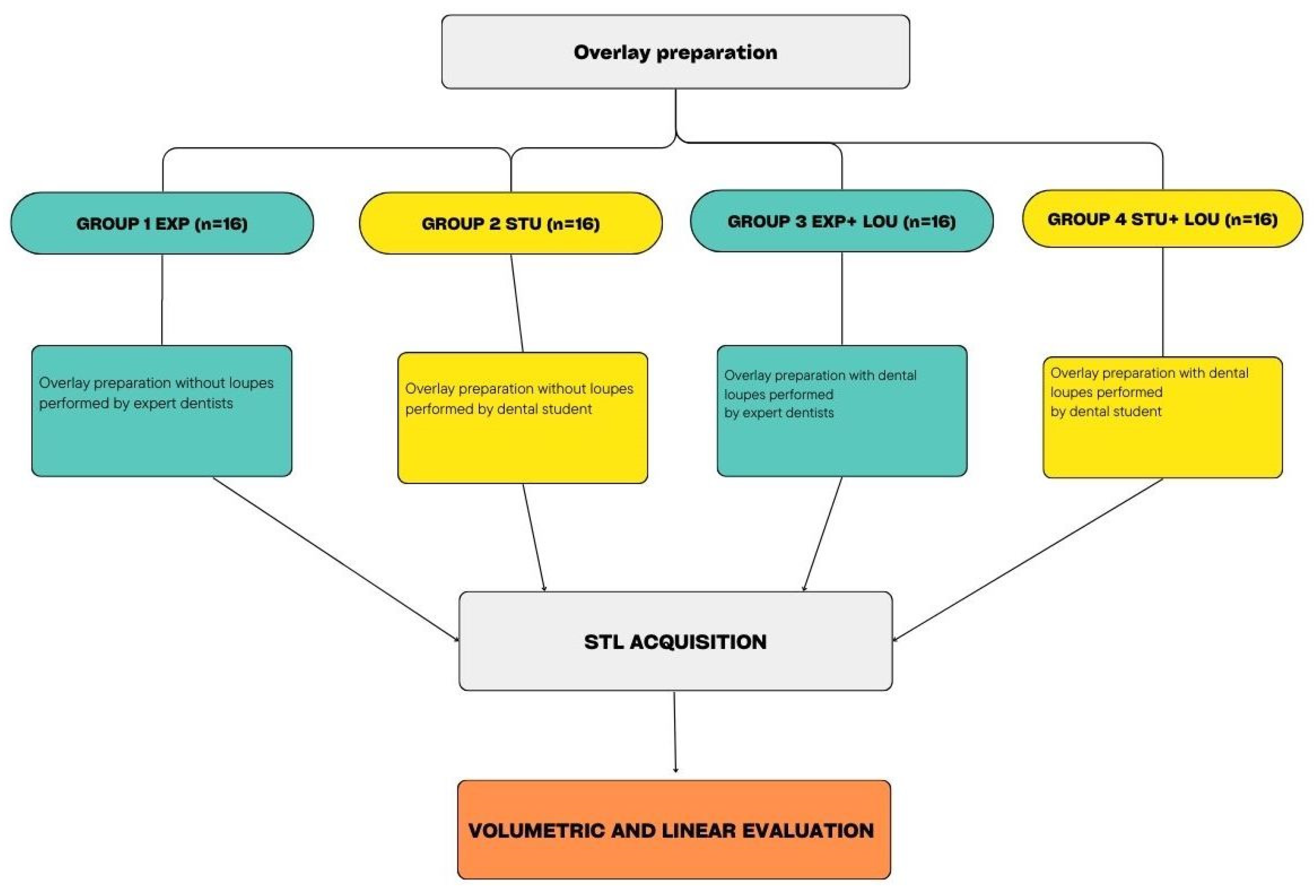
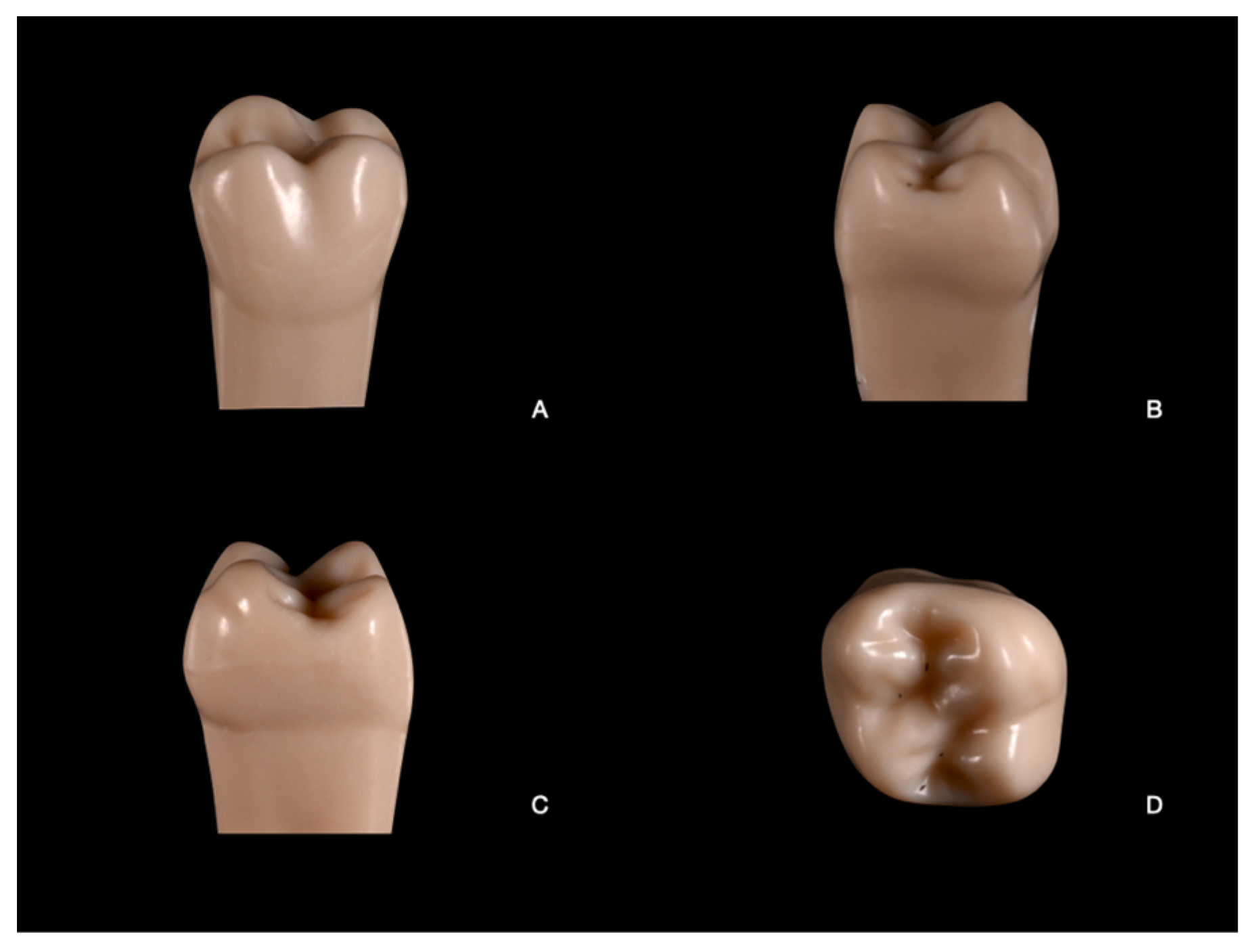
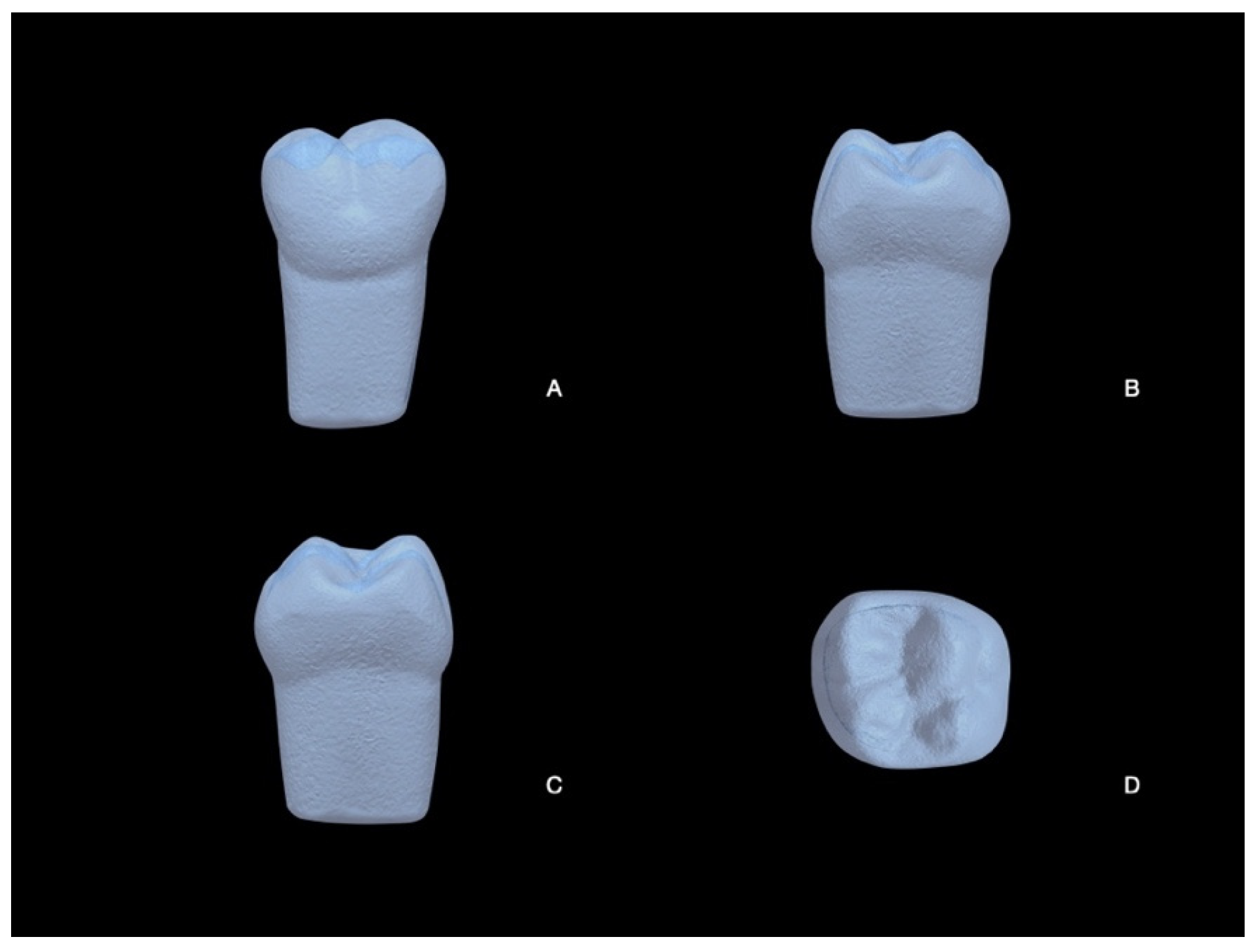
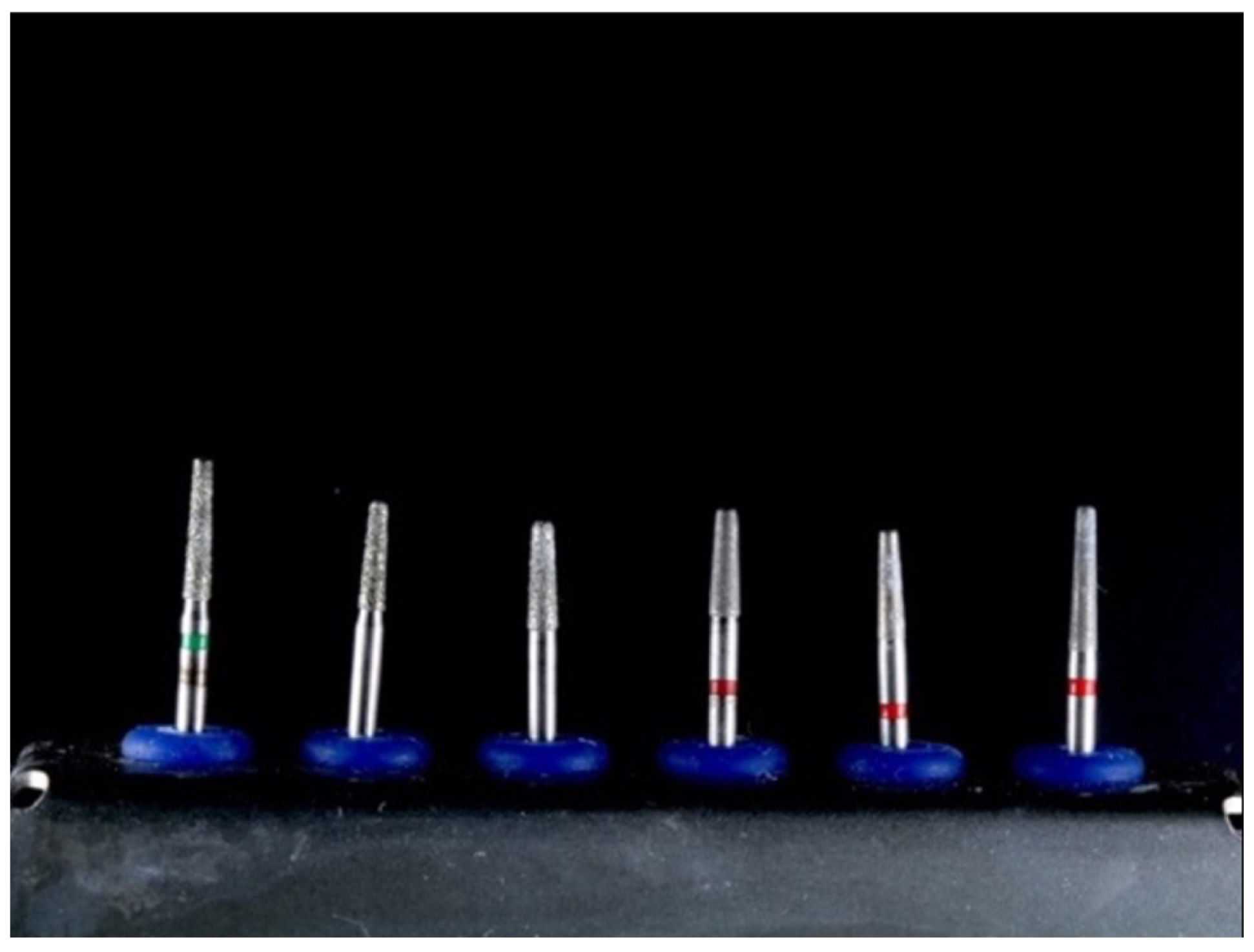
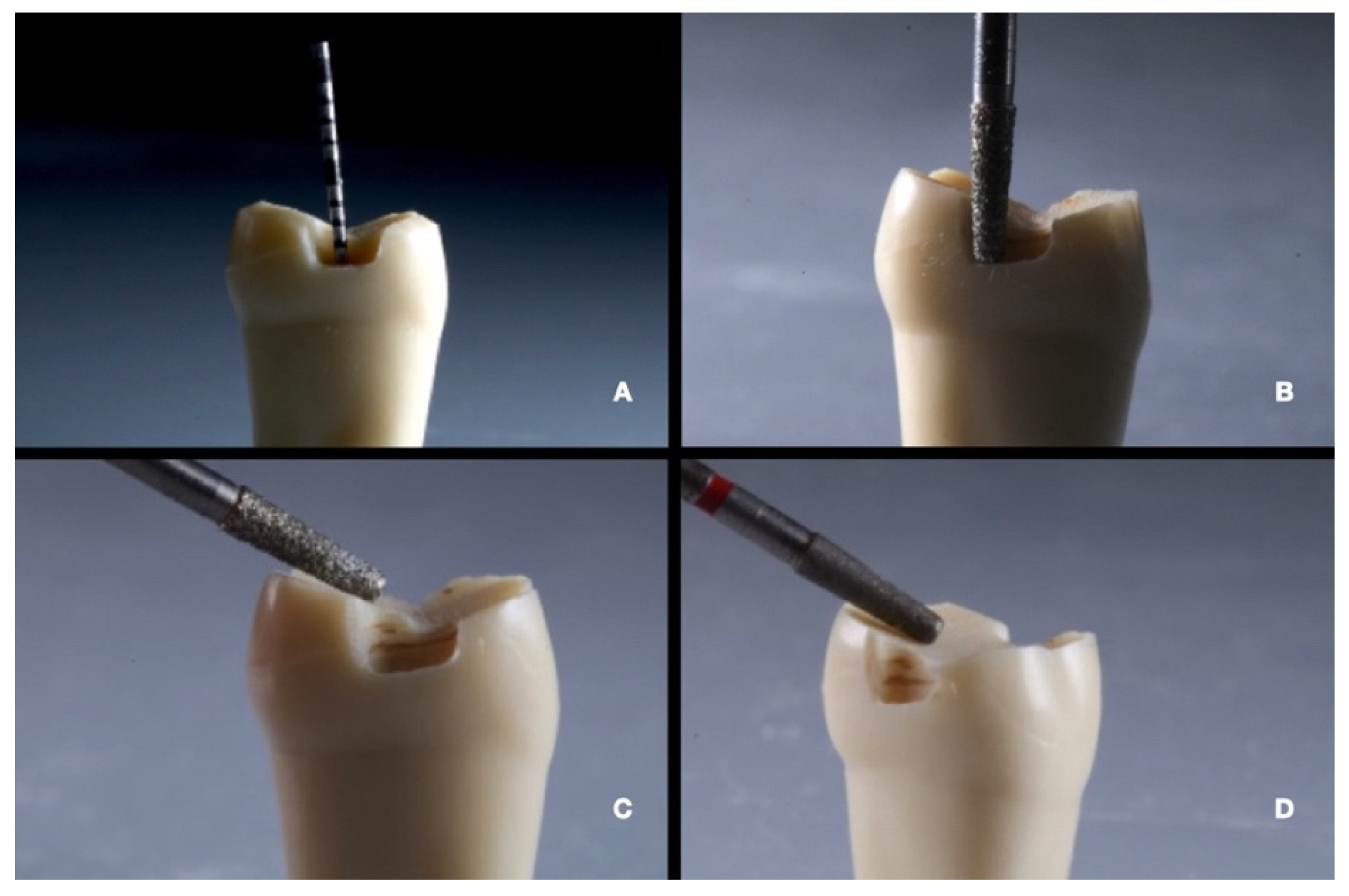




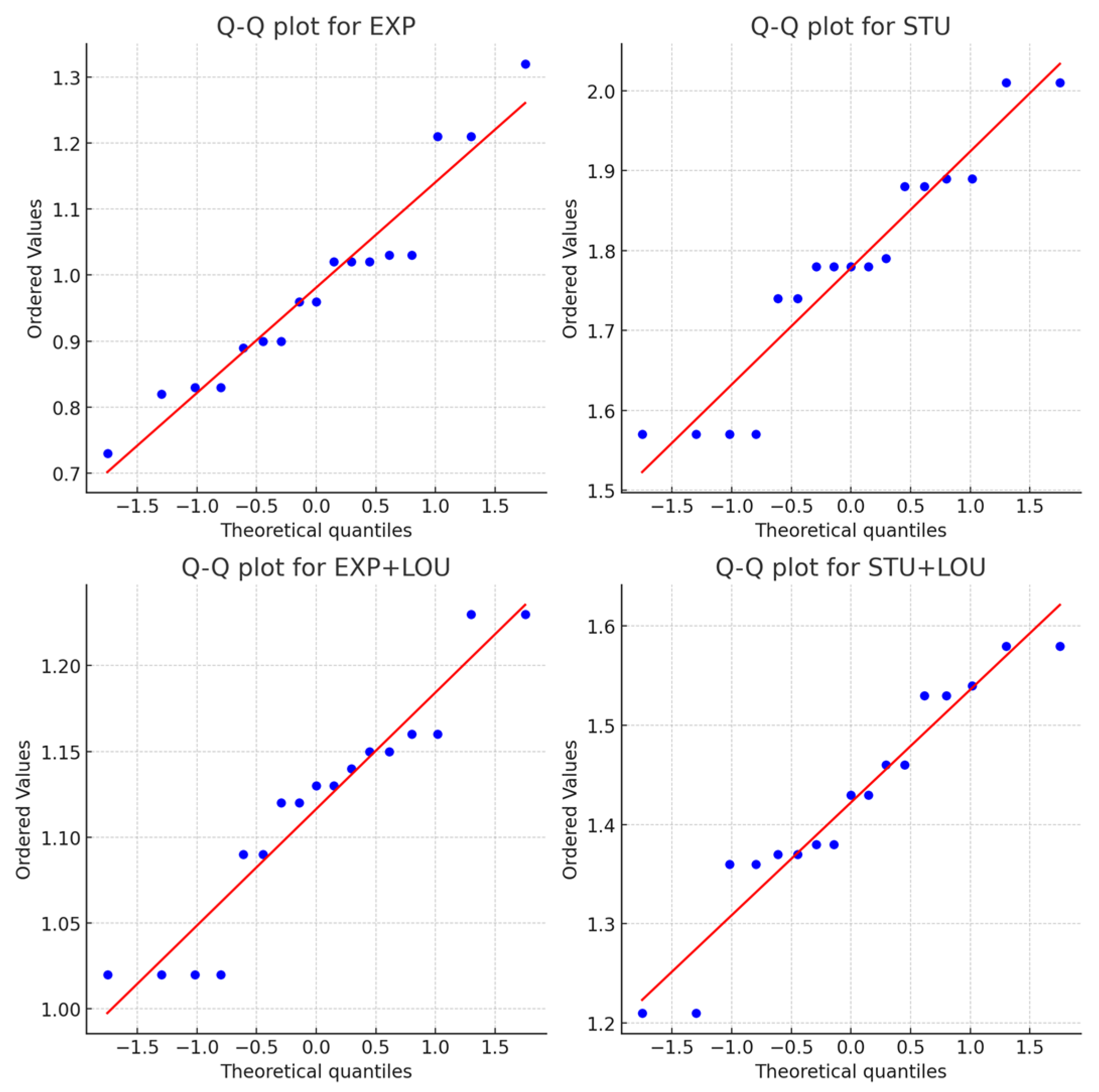
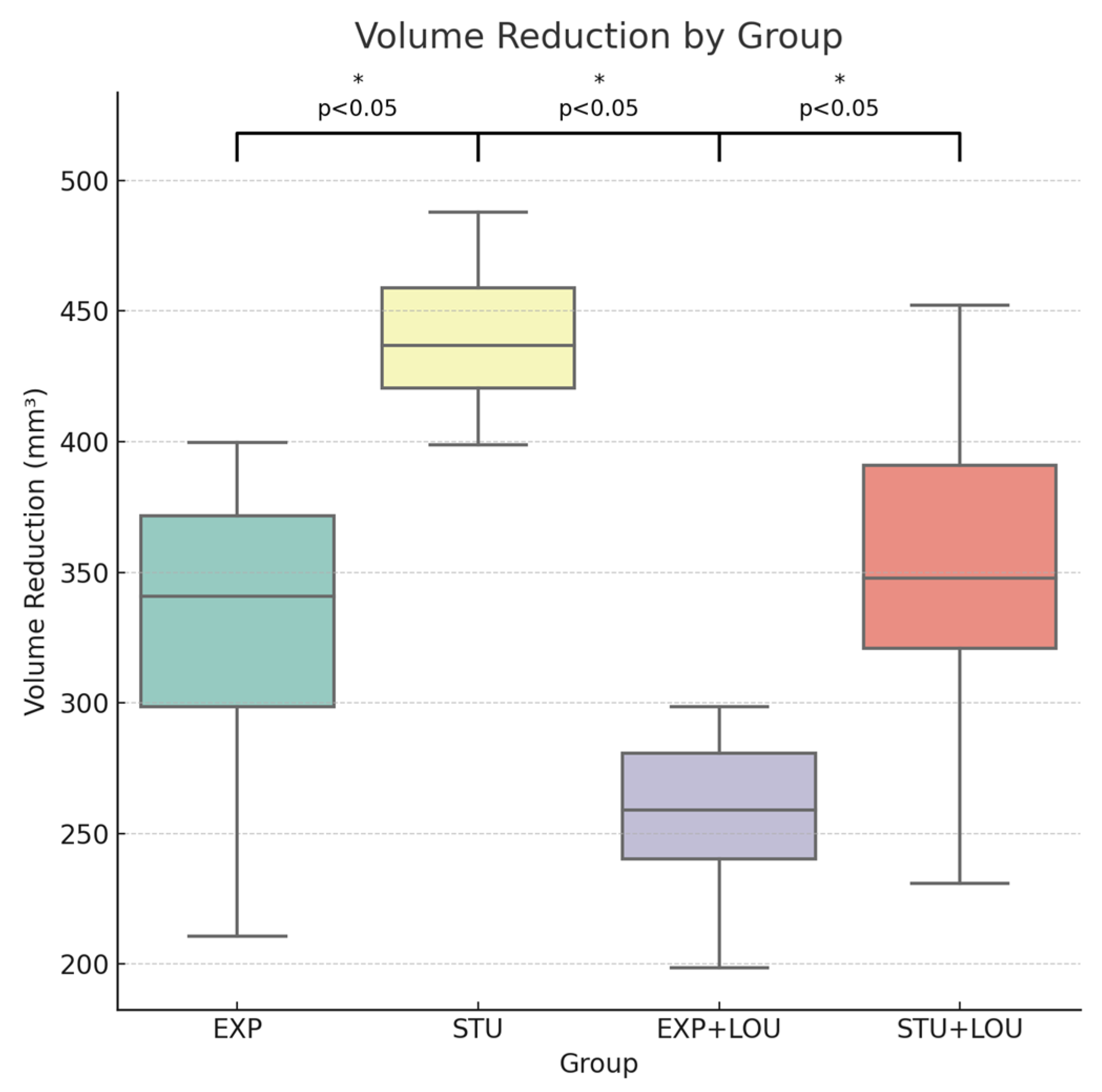

| VOLUME REDUCTION (mm3) | |||
|---|---|---|---|
| EXP | STU | EXP+LOU | STU+LOU |
| Mean | |||
| * 329,012 | * 442,236 | * 256,739 | * 351,338 |
| SD | |||
| 55,627 | 28,213 | 31,979 | 59,776 |
| CI (95%) | |||
| 223.241, 434.783 | 195.932, 317.546 | 388.589, 495.882 | 237.676, 464.998 |
| p-Value | |||
| Factor A (experience) < 0.05 (*) | |||
| Factor B (dental loupes) < 0.05 (*) | |||
| INTERPROXIMAL BOX width (mm) | |||
|---|---|---|---|
| EXP | STU | EXP+LOU | STU+LOU |
| Mean | |||
| * 0.945 | * 1.793 | * 1.129 | * 1.447 |
| SD | |||
| 0.175 | 0.142 | 0.072 | 0.122 |
| CI (95%) | |||
| 0.669, 1.321 | 1.528, 2.058 | 0.994, 1.263 | 1.219, 1.674 |
| p-Value | |||
| Factor A (experience) < 0.05 (*) | |||
| Factor B (dental loupes) < 0.05 (*) | |||
Disclaimer/Publisher’s Note: The statements, opinions and data contained in all publications are solely those of the individual author(s) and contributor(s) and not of MDPI and/or the editor(s). MDPI and/or the editor(s) disclaim responsibility for any injury to people or property resulting from any ideas, methods, instructions or products referred to in the content. |
© 2025 by the authors. Licensee MDPI, Basel, Switzerland. This article is an open access article distributed under the terms and conditions of the Creative Commons Attribution (CC BY) license (https://creativecommons.org/licenses/by/4.0/).
Share and Cite
Tafuri, G.; D’Addazio, G.; Santilli, M.; Argentieri, G.; Murmura, G.; Caputi, S.; Sinjari, B. Overlay Preparation Accuracy: An In Vitro Study on the Influence of Magnification and Operator Expertise. Prosthesis 2025, 7, 5. https://doi.org/10.3390/prosthesis7010005
Tafuri G, D’Addazio G, Santilli M, Argentieri G, Murmura G, Caputi S, Sinjari B. Overlay Preparation Accuracy: An In Vitro Study on the Influence of Magnification and Operator Expertise. Prosthesis. 2025; 7(1):5. https://doi.org/10.3390/prosthesis7010005
Chicago/Turabian StyleTafuri, Giuseppe, Gianmaria D’Addazio, Manlio Santilli, Giulio Argentieri, Giovanna Murmura, Sergio Caputi, and Bruna Sinjari. 2025. "Overlay Preparation Accuracy: An In Vitro Study on the Influence of Magnification and Operator Expertise" Prosthesis 7, no. 1: 5. https://doi.org/10.3390/prosthesis7010005
APA StyleTafuri, G., D’Addazio, G., Santilli, M., Argentieri, G., Murmura, G., Caputi, S., & Sinjari, B. (2025). Overlay Preparation Accuracy: An In Vitro Study on the Influence of Magnification and Operator Expertise. Prosthesis, 7(1), 5. https://doi.org/10.3390/prosthesis7010005










